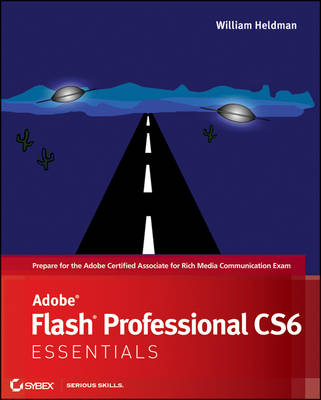
Adobe Flash Professional CS6 Essentials
John Wiley & Sons Inc (Verlag)
978-1-118-12965-4 (ISBN)
- Titel ist leider vergriffen;
keine Neuauflage - Artikel merken
You′ll get quickly up to speed on the essentials of Adobe Flash with this clear, task–based book. From the fundamentals of rich media design to specific techniques, it′s a thorough introduction. Using step–by–step instruction, this book clearly shows you how to draw shapes, use the Timeline, add video or audio, create complex animations, and much more. Moreover, if you′re preparing for the Flash Professional Adobe Certified Associate (ACA) exam, this thorough guide is the perfect preparation.
Covers Flash essentials for beginners and assists candidates preparing for the Adobe Certified Associate (ACA) for Rich Media Communication Using Flash Professional certification
Introduces you to the principles and practices of rich media design as well as Flash basics and essential tools
Delves into topics and techniques, including creating designs using Flash shape tools, the essentials of layers and the Timeline, using text and symbols, and creating simple animations
William Heldman is the Computer Science and Game Development instructor at Warren Tech (www.warrentech.org), a Career and Technical Education (CTE) high school in Lakewood, Colorado. He is the author or coauthor of several Sybex books, including the CompTIA Project+ Study Guide.
Introduction xxi
CHAPTER 1 Before Jumping into Flash: Rich Media Design
Principles and Practice 1
Working with Clients to Create Rich Media Projects 1
What Is Rich Media? 2
Viewing Great Rich Media Examples 3
Identifying Your Content’s Purpose and Audience 7
Choosing the Best Media Types 10
Addressing Accessibility Issues in Rich Media 12
Designing for People Who Are Blind 14
Designing for Low–Vision Viewers 18
Designing for Hearing–Impaired and Deaf Viewers 23
Designing for People with Physical Limitations 27
Designing for People with Cognitive Limitations 28
Designing for People with Photosensitive Epilepsy 28
Understanding Project Management 101 28
Identifying a Project 29
Creating the Project Plan 29
Creating the Project Schedule 31
Properly Closing Out the Project 32
Understanding Copyright Issues When Using Others’ Work 32
Understanding Text Copyright 33
Understanding Music Copyright 34
Understanding Video Copyright 34
Understanding Animation Copyright 34
Understanding Trademarks 35
CHAPTER 2 Getting Acquainted with Flash 37
Opening Flash for the First Time 37
Using Flash Panels 40
Frequently Used Panels 41
Other Handy Panels 43
Understanding Flash Workspaces 45
Understanding Flash File Types 47
FLA 48
SWF 48
HTML 49
CHAPTER 3 Drawing Shapes in Flash 51
Drawing Standard Shapes 51
Understanding Merge vs. Object Drawing 58
Creating Objects in Merge Drawing Mode 58
Creating Objects in Object Drawing Mode 60
Drawing Primitive Shapes 62
Drawing Polygonal or Star Shapes with the PolyStar Tool 65
Making Artsy Shapes with the Deco Tool 66
Drawing Other Shapes 68
Working with Color in Flash 75
Using kuler 75
Saving a Color Set 77
Working with Color Gradients 77
CHAPTER 4 Getting Started with the Timeline 81
Becoming Acquainted with the Timeline 81
Adding Different Frame Types to Your Animation 83
Copying and Deleting Frames 88
Frame Names 90
Organizing Your Work with Layers 91
Creating a UFO Scene 92
Hanging the Moon 96
Organizing Your Layers: Using Layer Folders 98
Working with Special Layer Types 102
Aligning Objects with Snapping 105
CHAPTER 5 Adding Flash Text and Fonts to Your Creat ions 109
Understanding When You Can Use TLF Text Fields 110
Flash Player 110
ActionScript 111
Flash Builder 112
Picking the Best Font 112
Choosing Serif or Sans Serif 112
Embedding Your Font 114
Using Placeholder Text 116
Checking Your Spelling 116
Using Classic Text 117
Deciding to Use Classic Text 117
Inserting Classic Text Boxes 117
Using Text Layout Framework 120
Deciding to Use TLF 120
Inserting TLF Text Boxes 121
CHAPTER 6 Working with Flash Symbols 129
Creating Graphic Symbols 129
Converting Assets to a Symbol 130
Grouping Assets 132
Using the Library 134
Using the Symbols from the Library 134
Implementing a Library Naming Convention 135
Grouping Common Objects in the Library 135
Creating Button Symbols 136
Manually Creating a Button 138
Turning the Button into an Instance 140
Editing a Button 140
Using a Prebuilt Button 143
Creating Movie Clip Symbols 144
Creating and Editing Symbol Instances 146
Understanding ActionScript Linkages 148
CHAPTER 7 Developing Simple Flash Animations 155
Developing Storyboards to Describe Your Animation 155
Creating a Storyboard for Cow Abduction 156
Animating the Cow Abduction 159
Creating a Frame–by–Frame Animation 165
Differentiating between a Stage Animation and a Movie Clip 171
CHAPTER 8 Using Tweens 175
Creating Shape Tweens 175
Making Changes to a Shape Tween 178
Adding Shape Hints 181
Creating Motion Tweens 183
Rotating Objects 185
Using Parallax Scrolling 186
Applying Granular Changes with the Motion Editor 189
Making Animations More Realistic with Easing 190
Using Motion Presets 192
Understanding Classic Tweens 194
CHAPTER 9 Techniques for Creating More Technical Animations 199
Creating a Bicycle with Rotating Wheels 199
Drawing the Crank Arms 200
Creating the Pedals 202
Repeating the Process for the Three Arcs 204
Creating the Sprocket 206
Creating the Tires 207
Creating the Bike Frame 209
Assembling the Bike 211
Setting Different Speeds Using Parallax Scrolling 213
Creating the Buildings 213
Adding Some Clouds 215
Assembling the Scene 216
Adding a Highway 217
Creating a Bouncing Ball with Color Gradients, Motion Presets, and Eases 218
Creating the Basketball Court’s Floor 218
Adding Pizzazz with Custom Color Gradients 219
Creating a Backboard by Combining Motion Tweens 222
Tweaking the Animation 225
Adding Perspective to the Basketball Scene with 3D Tools 225
CHAPTER 10 Creating Characters with Inverse Kinematics 231
Boning a Character 231
Snapping a Photo as a Base 231
Tracing Your Picture 233
Inserting Bones into Your Character 237
Constricting Animations 240
Animating IK’d Objects 242
Creating the Bicycle Animation 242
Creating Bouncing Movement Using IK Springs 244
CHAPTER 11 Working with Audio 251
Creating a Rich Media Project with Audio 251
Creating the Drum Set 253
Drawing the Bass Drum 254
Drawing the Bass Drum Hoops 254
Making the Drum Head 255
Moving the Back Hoop into the Back of the Front Hoop 256
Creating the Drum Shell 257
Drawing and Placing the Lugs and Rods 258
Creating the Tom–Toms and Snare 260
Making the Cymbals and Cymbal Stands 261
Drawing the Cymbal Stand 261
Drawing the Scissor–Style Brace for the Cymbal Stand Legs 263
Creating the Cymbal 266
Creating the High–Hat Stand and Cymbals 267
Adding Sounds to the Drums 268
Importing the Sounds and Preparing for ActionScript 268
Creating the Buttons 269
Adding a Hit Zone to the Cymbals 271
Compressing Audio 272
Using the Sounds Supplied with Flash 273
Putting a Sound on the Stage 274
Controlling a Sound with a Code Snippet 274
CHAPTER 12 Working with Video 279
Understanding Supported Flash Video File Types 279
Converting Non–supported File Types 281
Using the Import Video Wizard 282
Setting Up ActionScript Cue Points 289
Adding ActionScript Cue Points to Your Video 289
Adding Parameters to Cue Points 292
Adding the Buttons 293
CHAPTER 13 Working with ActionScript 299
Getting Started with ActionScript 299
ActionScript Basics 300
Working with Dynamic Text 303
Programmatically Adjusting a Text Object’s Coordinates and Formatting 304
Testing Your Work 305
Programming ActionScript to Calculate Your BMI 308
Writing the Code to Declare Variables and Hide Dynamic Text Fields 310
Garnering User Input 312
Calculating and Outputting the Results 314
Publishing Your Work 317
APPENDIX A Adobe Rich Media Communication Using Flash Professional CS6 Objectives 323
APPENDIX B Next Steps 327
Index 331
| Erscheint lt. Verlag | 10.7.2012 |
|---|---|
| Verlagsort | New York |
| Sprache | englisch |
| Maße | 188 x 228 mm |
| Gewicht | 836 g |
| Themenwelt | Informatik ► Office Programme ► Outlook |
| Informatik ► Web / Internet ► Web Design / Usability | |
| ISBN-10 | 1-118-12965-2 / 1118129652 |
| ISBN-13 | 978-1-118-12965-4 / 9781118129654 |
| Zustand | Neuware |
| Informationen gemäß Produktsicherheitsverordnung (GPSR) | |
| Haben Sie eine Frage zum Produkt? |
aus dem Bereich


